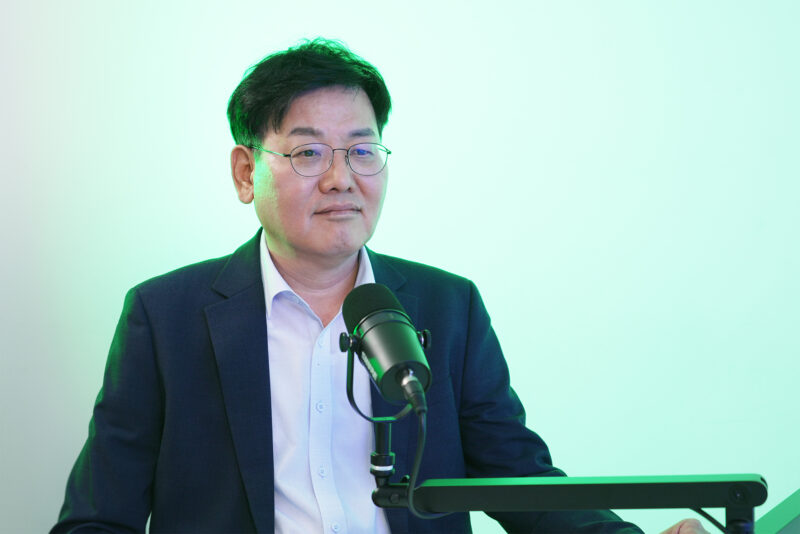- Funding Stage : Pre-series A
- Raising amount : KRW 3 B
- Desired Fundraising Timeframe : 3Q 2025
In covering biotech startups, Wowtail frequently highlighted antibody-related innovations. Antibodies bind to antigens on pathogens or cancer cells, recruiting immune cells to eliminate them or, in antibody-drug conjugates (ADCs), delivering drugs to directly kill cancer cells. Shaped like a Y, antibodies feature two upward “branches” (Fab regions) that bind antigens and a downward “stem” (Fc region) that attracts immune cells.
However, the Fc region poses a critical issue. Immune cells have FcγR (Fc gamma receptors) that interact with the Fc region. In ADCs, immune cells may inadvertently bind to the Fc, causing the ADC to kill immune cells instead of cancer cells, leading to severe side effects in organs like the liver, lungs, or lymph nodes where immune cells concentrate.
Today’s featured company, CrossPoint Therapeutics, aims to address these Fc-related side effects to become a global platform for antibody drug development. Founded in October 2022 by CEO Taeuk Kim, former head of the National Conference for New Drug Development and CEO of LeadCompass Investment, the company is driving innovation.
One might wonder why not use Fc-free antibodies for ADCs. However, removing the Fc drastically shortens the antibody’s half-life, as it plays a key role in extending it, leading to rapid degradation in the body. Research has long focused on retaining the Fc’s half-life extension while blocking its FcγR interactions. CEO Kim emphasized, “CrossPoint developed Stealth Body, an antibody that eliminates Fc side effects, outperforming technologies from global leaders like Genentech and Genmab.”
Stealth Body, as the name suggests, is an antibody that “silently” reaches cancer cells without interacting with immune cells. How does it achieve Fc silencing? Kim explained, “Stealth Body minimizes side effects by rearranging gene sequences during antibody production.” Since antibodies are proteins, efforts to rearrange amino acid sequences to reduce Fc side effects, like the LALA mutation (swapping two leucines for alanines), have been adopted by many global biotech firms. However, Kim noted that Stealth Body demonstrates greater stability and superior cancer-killing ability compared to LALA mutants in experiments.
Kim added, “Based on mouse data, we’re pursuing monkey studies, which are closest to humans.” If monkey data replicates these results, CrossPoint plans to license the technology to global biotech firms.

Kim attributed these achievements to the team’s expertise, stating, “Our team’s combined drug development experience exceeds 100 years.” Led by CTO Kihwan Jang, with over 20 years in antibody research, the team forms CrossPoint’s competitive edge.
If Stealth Body proves its performance, global biotech firms, particularly in the ADC space, are likely to court CrossPoint. Kim revealed that Pfizer and Daiichi Sankyo have held meetings, showing interest, and a technology transfer deal with a listed Korean biotech is expected in early June. However, securing monkey data is critical for larger deals. To fund these experiments, CrossPoint is raising USD 2.14 million (KRW 3 billion) in a Pre-Series A round, needing one final investor to close. In today’s cautious biotech investment climate, this presents a challenge. Investors curious about Stealth Body’s Fc silencing and CrossPoint’s vision should visit their Dongtan office to learn more.
What problem is CrossPoint trying to solve?
We aim to eliminate side effects from interactions between antibody Fc regions and the body’s 1.7 trillion immune cells, creating a smart delivery system that targets specific cells precisely.
Over the past 30 years, antibodies have been developed as delivery vehicles for drugs or cells. However, when the Fc region binds to six types of Fc gamma receptors or C1q receptors on immune cells, it triggers ADCC, ADCP, or CDC effects, or diverts drugs to immune cells instead of targets like cancer cells, causing severe side effects.
Our Stealth Body (Fc-silenced antibody platform) addresses these issues, offering advantages in autoimmune therapies, ADC development, and immune-oncology drugs via immune cell activation.

How does it solve this problem?
Efforts to eliminate Fc effects date back to early antibody drug development but intensified with autoimmune therapies and immune-oncology drugs like PD-1/PD-L1. The simplest approach—physically removing the Fc—reduces the antibody’s half-life significantly. Thus, technologies have focused on engineering gene sequences to modify the Fc, preserving Fab’s target selectivity while blocking all Fc gamma and C1q receptor binding, maintaining antibody stability and productivity—a complex challenge.
Genentech and Genmab hold leading patented technologies, but they still bind to some Fc gamma receptors and face stability or productivity issues. Our Stealth Body modifies Fc gene sequences, achieving complete receptor silencing without compromising stability or half-life, outperforming competitors.
What are our competitive advantages and technical strengths compared to competitors?
The long half-life of antibodies is a key advantage, so physically removing the Fc was never an option. Like Genentech and Genmab, our Stealth Body modifies Fc gene sequences, but it binds to no Fc gamma or C1q receptors and maintains antibody stability and half-life, offering superior performance.

What products/services do we offer, and what is their current status?
Stealth Body offers advantages across drug development but focuses on ADCs, a hot topic in oncology. We aim to develop next-generation ADCs with lower minimum effective doses (MED) and improved highest non-severely toxic doses (HNSTD), enhancing safety.
Despite high efficacy, ADCs face severe (grade 3+) side effects in over 50% of patients, limiting their use as first- or second-line therapies and causing pipeline failures. Initially, unstable linkers connecting antibodies to payloads were blamed, but stabilizing linkers paradoxically increased side effects. We believe Fc-receptor interactions in immune-rich organs (lymph, liver, lungs, eyes) drive these issues. Stealth Body lowers MED and raises HNSTD, as validated in animal models across ADC targets.
We’ve secured animal data showing sufficient anticancer effects at lower doses by blocking immune cell binding. Next, we’ll validate HNSTD in monkey models, enabling large-scale global pharma licensing if successful.
What is our target market size, and who are our core customers?
Over 20 global pharmas are developing ADCs, but post-Enhertu (Daiichi Sankyo), clinical data from 2024–2025 cancer conferences show struggles with safe, effective ADCs.
This gap is our business development focus. Our primary strategy is licensing ADC pipelines to global pharmas at the preclinical stage, emphasizing:
Therapeutic Index (HNSTD/MED), a key metric for ADC licensing decisions.
EGFR-targeted ADCs, which face repeated failures due to side effects but offer broad applicability, where Stealth Body demonstrates clear differentiation.
PD-L1-targeted ADCs, combining immune-oncology and ADC benefits, with our antibodies showing internalization rates comparable or superior to Pfizer’s, currently under validation.

What is our business model?
Our business model comprises four components:
Given the capital and time required for drug development, full-scale clinical development and launches will begin post-IPO.
Pre-IPO, we target large-scale global pharma licensing, licensing ADCs pre-clinically and immune-oncology drugs post-early clinical data.
Stealth Body’s versatility as a selective delivery vehicle enables applications in immune-oncology, ADC, autoimmune, and metabolic therapies, fostering joint research and licensing.
Over the next decade, we anticipate growth in RNA-conjugated drugs, aiming to upgrade Stealth Body for Antibody Oligonucleotide Conjugation platforms.
What are CrossPoint’s achievements?
Validated Stealth Body’s applicability to various antibody therapies, confirming versatility in immune-oncology and ADC targets, with derivative patents filed.
In immune-oncology, in vitro and mouse data show reduced immune-mediated side effects with Stealth Body.
For ADCs, in vitro data demonstrate superior safety and cancer-killing ability compared to standard or LALA-mutant antibodies, with candidate molecules selected for monkey safety tests, showing efficacy at lower doses.
In business development, we’ve initiated 2025 global pharma engagements, confirming high interest from Pfizer and Daiichi Sankyo in Fc-silenced technologies. A material transfer agreement with a listed Korean biotech for platform validation is nearing results.

What is the CrossPoint team’s competitiveness?
Our seven-member team, including three senior leaders, boasts over 100 years of drug development experience. CTO Kihwan Jang, with over 20 years in antibody drug development, has led projects from discovery to early clinical stages, including a cancer drug licensed to a global pharma, offering unmatched expertise for an early-stage biotech.
Why should we receive investment? Three reasons!
We possess a precise drug delivery technology evading 1.7 trillion immune cells, with data proving superiority over Genentech and Genmab’s leading solutions.
Applying Stealth Body to ADCs addresses critical safety unmet needs, with in vitro and mouse data confirming lower MED, enhancing Therapeutic Index.
Monkey model HNSTD validation could unlock global licensing, boosting enterprise value and offering high investment returns with reduced early-stage risks due to a pending biotech licensing deal.

MORE FROM THE POST
- [Korean Startup Interview] SimfliBIO Challenges NGS with Advanced Liquid Biopsy for Global Cancer Diagnostics Market
- [Korean Startup Interview] Beyondmedicine, Pioneering World’s First Digital Therapeutic for TMJ Disorders
- [Korean Startup Interview] Peptirna Therapeutics Aims for Global siRNA Market with Peptide Delivery Platform
- [Korean Startup Interview] KINGO Bio Challenges Global Giants with Innovative Clean Up Beads Solution ‘GraBeads’
- [Korean Startup Interview] OCULIGHT: Shining a Light on Safer, More Accurate Cataract Surgeries
- adc
- antibody
- BioHealth
- cancer
- CrossPoint
- crosspoint therapeutics
- Interview
- Korea
- Startup Together
- wow together
- WOWTALK
Share
Most Read
- 1
- 2
- 3
- 4
- 5




Leave a Reply